Design to Protect
Fenestration systems for extreme threat resistance
![]() Continuing Education
Continuing Education
Use the following learning objectives to focus your study while reading this month’s Continuing Education article.
Learning Objectives - After reading this article, you will be able to:
- Describe the methodology used to limit or manage risks to facilities.
- Discuss at least three major criminal/terrorist threats to facilities.
- Define the typical severity and product resistance levels for these threats, with a focus on fenestration systems.
- Examine combined threat resistance and the challenges of designing to this criteria.
As security threats continue to escalate around the world, demand for greater threat resistance in buildings increases at the same rapid rate. What formerly was a priority mainly in diplomatic and military facilities now extends not just to high-risk facilities, but to critical infrastructure like data centers, power generation plants, oil and gas centers and equipment, chemical manufacturing and transport, and centers of water supply and mass transit. Many other organizations, both public and private, are also seeking to incorporate higher levels of building protection into their physical security plans for commercial, financial, and educational centers. Since the 1995 bombing of the Alfred P. Murrah Federal Office Building in Oklahoma City, and even more intensively after the terrorist attacks of 2001, the safety of buildings and their occupants has become a concern in virtually every building type.

Photo courtesy of the U.S. Department of State
High-level physical security standards as well as innovative, sustainable design are built into the U.S. Embassy in Bujumbura, Burundi.
Fenestration in buildings—glazing, windows, doors, louvers, hatches, and other components—can be a key vulnerability, and thus it is an essential element of design for threat resistance. This course focuses on methods of understanding and responding to today’s most urgent physical threats: explosive blasts, ballistics, and forced entry. The information here can guide professionals in asking the right questions about fenestration products and design, and can help define levels of protection for people and property so that the products can become a positive part of the architectural design and overall function of the building. Products are now available that can provide effective protection for a wide range of security threats. They are used on high-risk facilities that require the highest levels of protection throughout the building and its site, and buildings that may be better served by more limited measures, such as designated safe rooms, hardened main entrances, and fortified control rooms. Often a measure that may be prohibitively expensive to use on an entire large commercial building can be effectively deployed to protect certain defined areas.
Through extensive testing, development of standards, and often harsh experience in buildings all over the world, the principles of designing for high-level threat resistance have evolved rapidly. A range of tested approaches and innovative products are available to provide solutions for architects, engineers, and security consultants as they design buildings to meet complex requirements with literally life or death consequences.
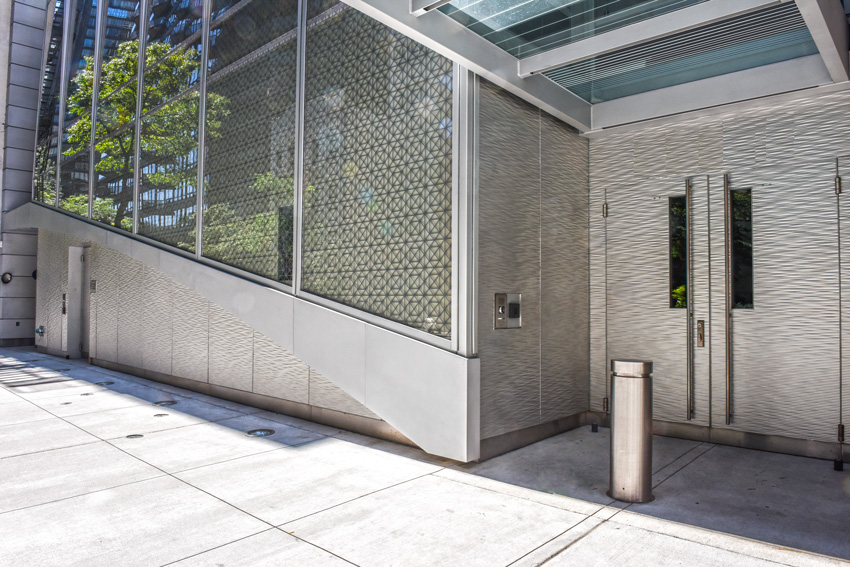
Photo courtesy of Ross Technology
While specialized fenestration products used throughout many high-risk buildings may be prohibitively expensive for lower-risk applications, they can be effectively deployed to protect critical or vulnerable areas, such as safe rooms, command centers, and exterior entrances, as shown here.
Methodology for Protective Design
Serious and often tragic attacks on American facilities have filled the news in recent years, not only involving diplomatic or military facilities but also civilian locations where heavy fortification was never a factor in the building’s original design. These events have turned urgent focus on the need for better ways to protect people, buildings, and assets from disasters caused by human aggressors.
A number of U.S. agencies provide detailed guidance for protective design in their facilities. Major criteria include:
- The Risk Management Process for Federal Facilities: An Interagency Security Committee (ISC) Standard, implemented in nonmilitary federal U.S. facilities.
- The Unified Facilities Criteria (UFC) Department of Defense Minimum Antiterrorism Standards for Buildings, developed for DOD facilities.
- The Department of State (DoS) Overseas Building Organization (OBO) Design Standards, developed for DoS properties. Since the magnitude of the threat to DoS buildings overseas is generally greater than in domestic facilities, the performance criteria are consequently more arduous. Products that meet DoS requirements are designed and tested to provide effective protection against specific threats according to these stringent criteria.
According to the ISC standard, “Risk is a function of the values of threat, consequence, and vulnerability. The objective of risk management is to create a level of protection that mitigates vulnerabilities to threats and the potential consequences, thereby reducing risk to an acceptable level.”
Although the exact components of the risk assessment process will necessarily vary depending on the specifics of the situation being evaluated, in general, these analyses address the same fundamental considerations:
Identify and prioritize the assets to be protected: This includes detailed analysis of occupants, equipment, and the functionality of the building itself, with primary, secondary, and any necessary additional relative rankings; for example, the key operations in a pharmaceutical or chemical manufacturing facility, the emergency priorities in a telecommunication center, or sensitive documents or devices in a diplomatic facility.
Determine asset value: This involves specific questions about the relative value of materials or areas in the facility: Which is most critical in an emergency? Which is the most vulnerable? How replaceable are the building contents? Is its value in its geographical location or prominence as a landmark or high-traffic area rather than its contents? What is the impact of a loss? For example, if the facility being assessed is an air-traffic control tower, a downtime of a few minutes may be a serious impact of loss, while in a social security office, a downtime of a few minutes would be minor. But it is also important to recognize that the consequences of an attack would likely extend beyond the building itself to the wider community, with potentially serious impacts; for example, if an explosive device were detonated in a chemical plant, or an attack on a data center disrupted service, or an electrical substation were put out of action.
Determine the nature and likelihood of aggression: Based on the asset profile, what is its relative usefulness to potential aggressors? How accessible is the site or the building to these potential threats?
Develop design criteria for threat resistance: This is the focus of this course. Answers to the fundamental questions above will guide decisions about what is required from the design of the system and the products involved. Standards and testing have evolved to help provide a precise framework. Obviously not every threat can be anticipated, and buildings can’t be designed to resist every threat at the highest possible level of security (although certainly there are facilities in the world engineered to the highest standards possible with current knowledge and materials).
To design effective measures for resistance—in this case, protective fenestration systems—it is necessary to define precisely the nature of the threat, the severity of the threat, and the level of protection that the system or product will provide, as outlined in the following section.
The earlier in the planning process that this analysis can be done, the more cost effectively the threat resistance measures can be integrated into the building’s overall design, construction, and mission.
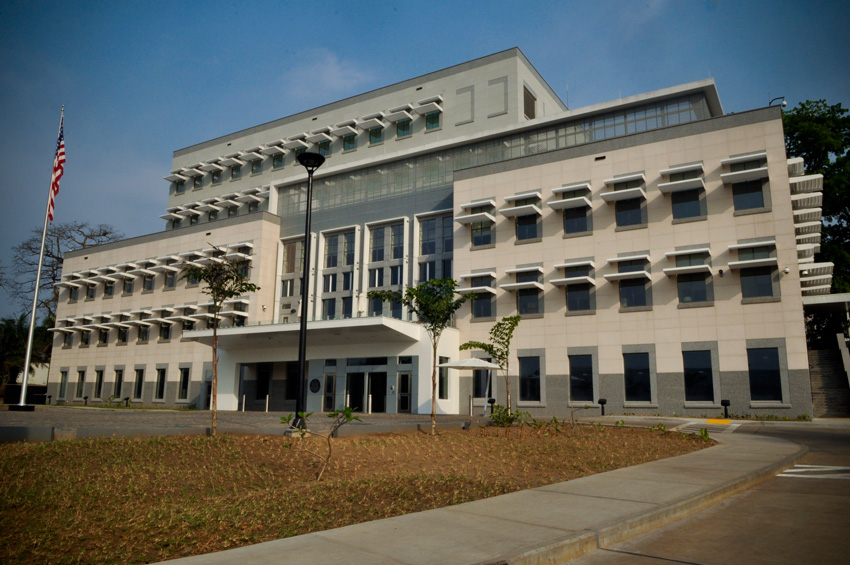
Photo courtesy of the U.S. Department of State
Many of the same specialized fenestration products used around the world in facilities requiring the highest levels of protection can also be used effectively in almost any building type to protect against a wide range of security threats. Shown here is the U.S. Embassy in Monrovia, Liberia.
Criminal/Terrorist Threats
There are many natural risks to buildings, such as weather, earthquakes, or fire, but even when focusing only on potential threats caused by human intervention, the list is significant, from unauthorized entry to disrupted operations by insiders to cyber and information security threats. This course focuses on three major physical threats to building security:
Blast threats: Explosive events that can cause widespread primary and secondary damage.
Ballistic threats: Damage from projectiles fired from firearms.
Forced entry: Attack on a structure by mobs or other intruders.
The most effective—and also the most challenging—fenestration design resists combined threats, integrating some level of protection against all of these. In each case, there is a direct line between the design and construction of the fenestration systems and the safety of the building and its occupants. The following sections will explain in more detail the nature of each threat, how levels of severity and levels of protection are determined for each, and how fenestration systems can be evaluated for their performance in resisting these threats.
And all of these measures must be developed in the context of the building’s overall function and architectural appeal. In some facilities, part of the protective strategy may be in giving the building the definite appearance of a forbidding, hardened stronghold as a strong visual deterrent. But in the majority of buildings, aesthetic appeal is a high priority, and a welcoming, nonthreatening exterior is important to the work being done inside. The most effective products provide design flexibility, ensuring that a high level of physical security in a building does not require constructing a featureless fortress.
Blast Resistance
Designing fenestration systems that will resist explosive blast is a complex challenge. When designing for combined threats, it is the addition of blast resistance that often requires specialized engineering. Yet the challenge is unavoidable. Incendiary devices and explosives were the most common weapons used in the 280-plus terrorist attacks in the United States from 2001 to 2014, and these devices have tragically become almost commonplace in other parts of the world.1
Explosive devices are typically either borne by vehicles or placed or carried by a human (although they can also be sent through the mail), with the objective of destroying facilities and killing people within the blast area. The pressure waves created from detonation can result in many types of damage, including extensive glass breakage, buckling and failure of walls and columns, and even the immediate collapse of the structure and progressive collapse of nearby buildings (see Building Damage from External Explosions). Overpressure and airborne debris can cause significant human casualties, and the explosive fireball and resulting fires may cause additional damage.
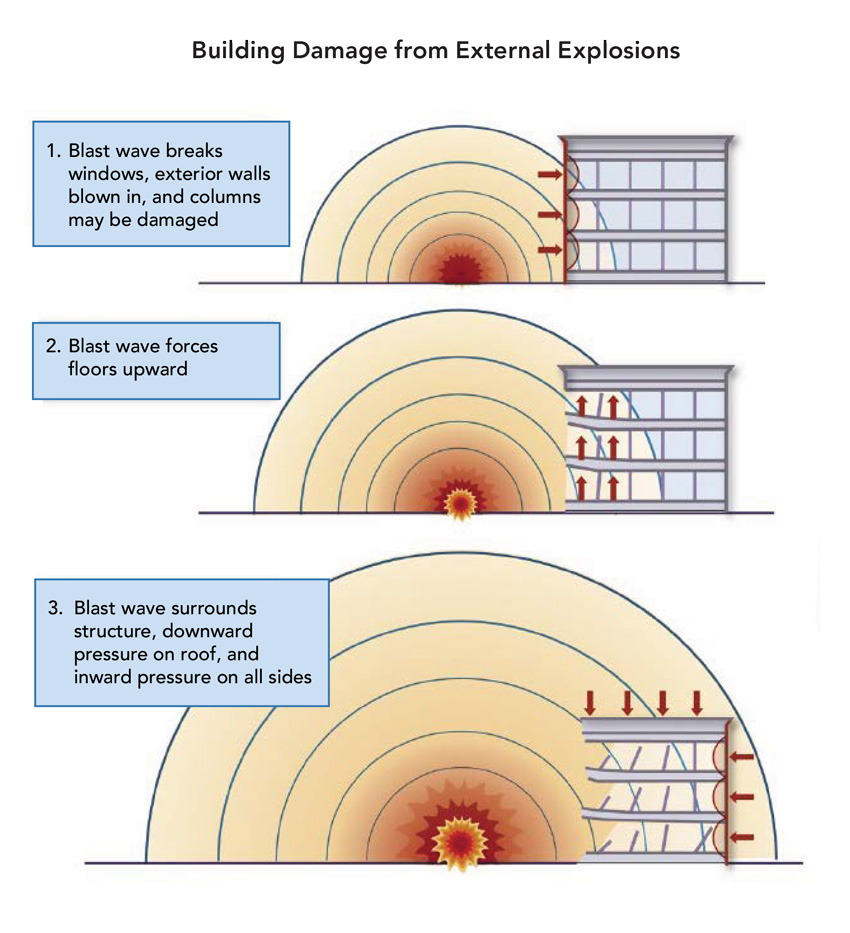
Source: FEMA 428/BIPS 07: Primer to Design Safe School Projects in Case of Terrorist Attacks and School Shootings, Edition 2, January 2012
Some of the key terms for describing and measuring the threat include:
- Overpressure: the pressure caused by the shock wave over and above normal atmospheric pressure, in pounds per square inch (psi). For example, window glass breakage may occur at 0.15-0.22 psi incident overpressure, panels of sheet metal will be buckled at 1.1-1.8 psi, and most buildings will probably be totally destroyed at 10-12 psi incident overpressure.
- Standoff distance: Distance between the building, people, or other assets and the center of the explosive blast. Creating at least minimum stand-off distances is a basic protective measure since every additional foot of standoff distance will mitigate the severity of the blast pressure wave.
- Net explosive weight or weapon yield: generally expressed as equivalent pounds of TNT.
The Explosive Threat Severity Chart shows an example of the relationship of factors involved in describing the severity of explosive threats, such as the standoff distance, explosive weight, and general types of delivery vehicle.
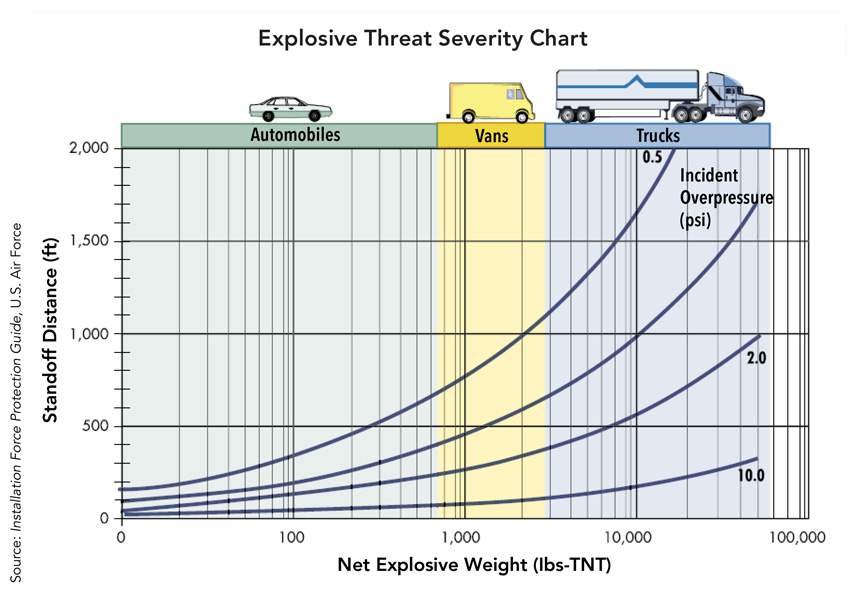
Source: FEMA 428/BIPS 07: Primer to Design Safe School Projects in Case of Terrorist Attacks and School Shootings, Edition 2, January 2012
The Explosive Threat Severity Table gives examples indicating the correspondence of damage to buildings to the size of explosions expressed in terms of incident overpressure.
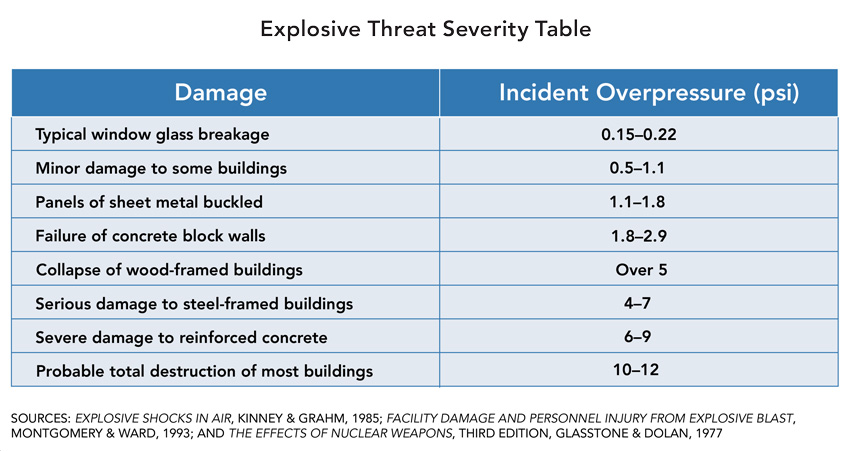
Source: FEMA 426: Reference Manual to Mitigate Potential Terrorist Attacks Against Buildings, December 2003
Blast resistance criteria have been developed by federal agencies, including the Department of State, General Services Administration, and the Department of Defense. ASTM has also developed a series of related standards that can be utilized to design and specify blast-resistant criteria for commercial structures and include ASTM F2912: Specification for Glazing and Glazing Systems Subject to Airblast Loadings and ASTM F2248: Practice for Specifying an Equivalent 3-Second Duration Design Loading for Blast Resistant Glazing Fabricated with Laminated Glass. In addition, an increasing number of large commercial projects are incorporating their own unique requirements for blast-resistant products.
Physical testing for blast resistance can be expensive and complex, requiring multiple samples and specialized equipment, such as outdoor shock tubes. But experienced manufacturers can contract with firms to perform engineering analyses for high-level blast loads.
To provide high levels of protection against high blast levels, all architectural features of the building must be hardened. For door and window systems, this primarily means sophisticated laminate systems: glass to absorb energy, and polycarbonate layers and coatings for flexure and protection.
The laminate is only one component of the system. One of the most important principles of blast-resistant design, as with design for other threats, is emphasis on the performance of the system as a whole, including the glazing, frames, and connectors or anchorage, as well as the reaction of adjacent elements in the building, such as walls and floors. For example, in an explosion, if a window system has a higher capacity than the supporting wall, when the wall fails, the entire window system may be blown into the facility.
Particularly in the case of blast resistance, reducing the level of protection will have a significant impact on the laminate construction, and thus on the cost of the overall system. For example, higher levels of protection typically require thicker laminates, heavier framing components, and anchors. Lowering the level of required protection may result in thinner glazing, lighter-weight framing, and lighter-weight or fewer connectors. But this is a sensitive balance. Blast overpressure transfers extremely high amounts of energy to the wall and adjacent structures, and all building components must be evaluated as a system in order to obtain confidence that a desired level of protection will be obtained.
This video contains a brief section of audio.
Video courtesy of Karagozian & Case
The test system shown in this short video was designed to withstand the effects of a significant blast. Note the blast wave as it impacts the structure and how quickly the blast occurs in real time.
Ballistic Threats
The ballistic threat is a projectile fired from a weapon, which results in the full or partial penetration of materials. The goal of a ballistic attack is to kill or incapacitate occupants or damage structures and equipment. Although in some parts of the world those weapons can include sophisticated artillery, for most facilities ballistic threats are most often bullets fired by handguns or rifles. In most design criteria, the severity of the threat is expressed in terms of the type of firearm and the bullet, and the level of protection is specified as how resistant the product in question is to the bullet’s effects.
There are several widely-used ballistic test methods that can be used to specify ballistic resistance of building elements. Each test method denotes specific testing criteria, including the ballistic threat in terms of a bullet type or size (e.g., 9 millimeters), the distance at which the test sample is placed, the number of samples, the testing temperature, and the material and location of the witness panel (a piece of material, e.g., aluminum foil, that is placed on the protected side of the sample for the purpose of determining whether fragments are produced during the ballistic test). The testing methods all take slightly different approaches, depending on the criteria, and the end users must select the test method most appropriate for their application.
The Ballistic Threat Severity Chart shows examples of threat severity levels defined in Underwriters Laboratories (UL) and National Institute of Justice (NIJ) criteria, related to specific weapons and ammunition.
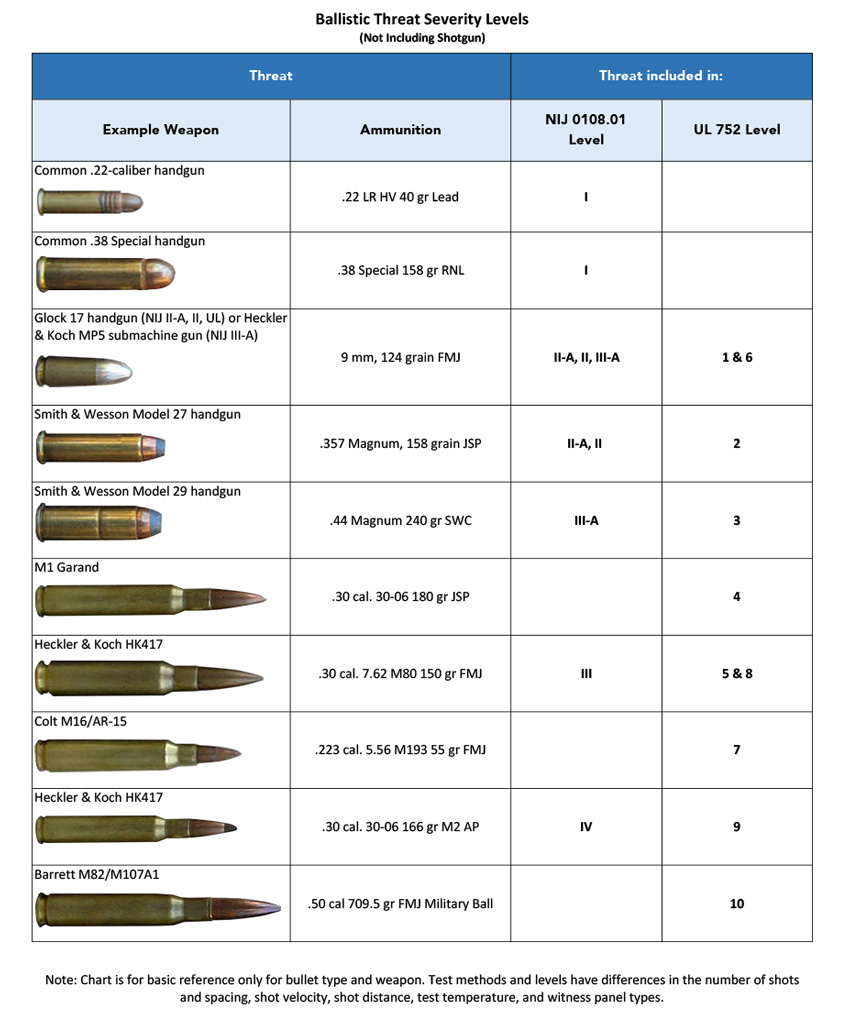
Image courtesy of Ross Technology
The level of protection defined in each ballistic test method measures the degree of bullet penetration through the surface and also the presence and amount of “spall,” flecks, or shards of material from the protective side of the laminate that might break away on impact and become projectiles themselves. Most written specifications require “no spall,” which is a “high” level of protection.
For building products, widely used ballistic test methods include:
- UL 752: defines 10 levels (plus shotgun) of protection
- National Institute of Justice (NIJ) 0108.01: defines six levels
- SD-STD-01.01 Rev G (Amended) Certification Standard Forced Entry and Ballistic Resistance of Structural Systems: defines three levels (plus shotgun) of protection
- ASTM F1233: defines 10 levels (plus shotgun)
The relative ability of various materials to resist three representative types of ammunition, generally from a lower threat level (for example, .44 Mag bullets) to a higher (7.62 M2AP bullets), is indicated in the Ballistic Threat Resistance Table. The definition of what level of protection would be “realistic” in any building is relative and depends on the nature and level of the threat, budget, building’s mission, and many other factors. For the purpose of comparison, the chart indicates a typical range of threat levels for which products are commercially designed and available. (Although it is possible to provide building components that can provide protection against more powerful ballistic threats—for example, against incendiary or .50 caliber armor-piercing ammunition—these products are not widely available for commercial applications.)
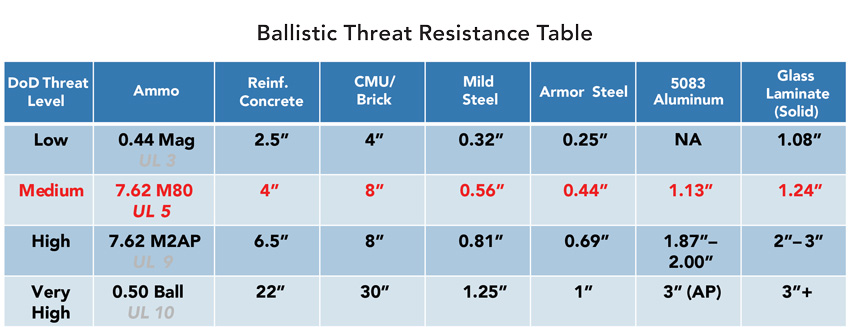
Image courtesy of Ross Technology
Manufacturers offer a number of fenestration products that meet ballistic threats, with innovative component and system designs that will work well in almost all building configurations. These systems feature multiple glass layers to dissipate the bullet’s energy and layers of plastic or film to capture spall, in frames of steel, armor plate, or thick aluminum, with all gaps protected. It is important to remember, particularly with large caliber rifle rounds, that a significant reaction can be transferred to the rest of the building structure when the ballistic-resistant glazing functions as designed and stops the penetration of a projectile.
Forced Entry
The most dramatic instances of forced entry have often occurred overseas, when large groups of people have attacked military, diplomatic, or politically symbolic facilities. But these buildings are also the ones more likely to be fortified against attack, while the vast majority of buildings, particularly in this country, have civilian missions. Their structures and glazing are not typically designed to resist this kind of threat, and so are particularly vulnerable to forcible entry.
The technical definition of the forced-entry threat is attack by personnel using a range of tools and methods to penetrate the protective covering of a facility. The range of motives can be as wide and as mixed as the tools used: to make a statement, to obtain sensitive or valuable materials, to create damage, or to cause injury to personnel. The level of forced-entry protection that products can provide is, as with other threats, a complex calculation, and many standards and specifications, both in the United States and worldwide, have been developed to quantify what is possible and realistic to achieve.
The forced-entry threat severity takes into account the size of the attacking group (e.g., two people, six people, etc.) and the type of tools used. For example, the Department of Defense’s “low” level of protection simulates an unstructured attack by a two- or six-man team using hand tools.
The level of protection is typically measured in terms of the delay time the product provides before an opening of defined size and/or shape is created. This delay can provide time for the destruction of documents, time for people to move to more secure locations, or time for response by local authorities. For example, in the Department of State SD-STD-01.01 Rev G (Amended) and ASTM F3038 test methods, the failure criteria is at the point when a defined test shape passes through a hole in the material being tested.
The Forced Entry Threat Severity Chart shows typical levels of protection in relationship to tools used, ranging from very low levels of protection, where a tested material can protect against light hand tools such as screwdrivers and punch tools, to very high levels of protection, where a material can withstand attack from all the tools listed previously, plus personnel-carried explosives. This particular description is based on DOD terminology; the definition of severity levels from forced entry varies from agency to agency, as does the definition of levels of protection.
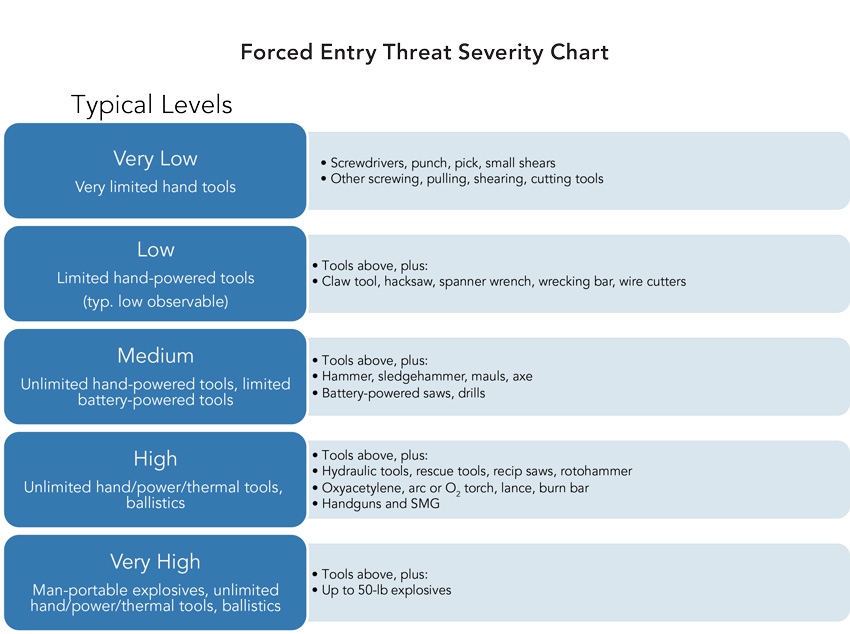
Image courtesy of Ross Technology
The Forced Entry Threat Resistance Diagram shows the levels of protection correlated to the delay time provided until a specific-size opening is created, as required by five different major standards.
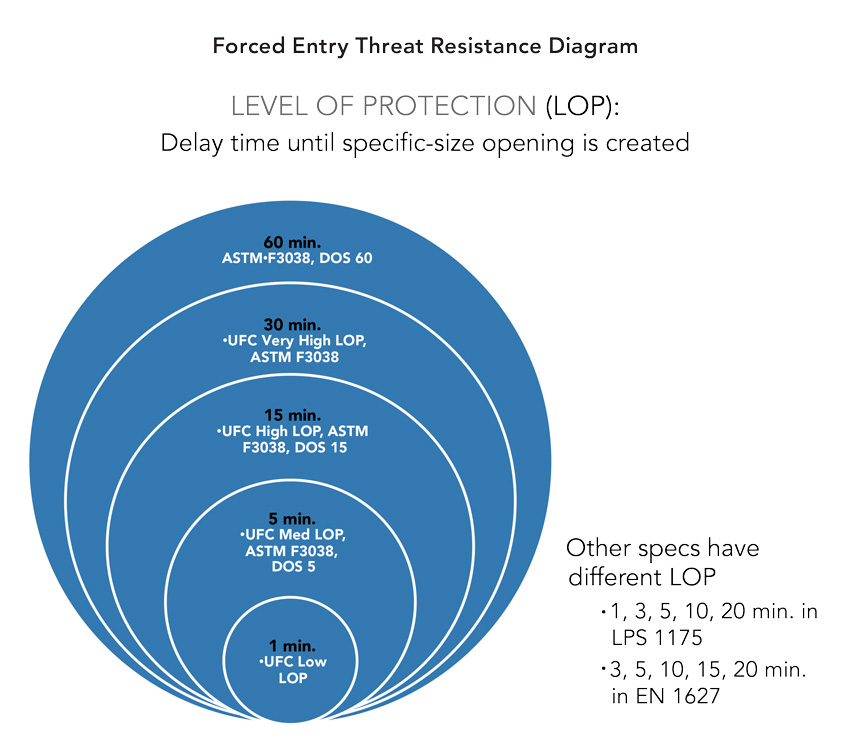
Image courtesy of Ross Technology
As the level of protection against forced entry increases, the building requirements increase significantly. For example, to provide a low level of protection (e.g., 1 minute against hand tools), commercially available products such as 11/16-inch glass-clad poly with 3/8-inch poly layer may be sufficient. To provide a very high level of protection (delay time) against this relatively low threat may require a laminate of 2 inches or more. For more severe threats and higher levels of protection, typical commercial window products are not realistic, and protection may have to include strongly reinforced doors with concrete fill, metal mesh, and other special features, together with heavily reinforced walls and other building structures.
As a point of reference regarding the severity of an attack using only hand tools, a single test for a product to meet a 60-minute level of forced-entry protection (ASTM F3038/DOS 60) can involve inflicting greater than 2,400 sledgehammer blows, along with attacks with combinations of pry bars, wood wedges, crowbars, and axes.
This video does not contain audio.
Video courtesy of Ross Technology
The systems shown in this short video are being tested using a variety of tools and techniques.
Glazing designed to resist forced entry generally includes layers of glass and thermoplastic materials (polycarbonate, acrylic). Products with higher amounts of plastic material are usually more resistant to blunt tool attacks, but glass provides resistance to sawing and cutting attacks. In addition, glass has features that are important in most buildings for aesthetics and also for transparency, light, vision, and scratch resistance. Frames can be manufactured from steel, armor plate, or thick aluminum; each has its advantages and disadvantages. Multiple anchorage locations can also increase the forced-entry resistance of the system.
There are a number of commercially available products in the United States that are rated as providing varying levels of protection against the forced-entry threat. These include systems rated to Department of State or ASTM F3038 standards, and individual components rated to H.P. White (independent testing organization) or ASTM F1233 standards. There are also a number of products in the United Kingdom and Europe that have been tested and classified to LPS1175 and EN 1627/1630 standards.
In addition, manufacturers—particularly those experienced in providing protection at Department of State/ASTM F3038 levels—have the capability to design and test proprietary laminates to resist forced-entry threats at various levels and to integrate them into a building’s other design priorities. This capability is also important in structures where designing for combined threats is an objective, because although a number of U.S. systems are rated for both forced entry and ballistic resistance, the addition of blast resistance is complex and usually requires specialized engineering that can only be provided by manufacturers with extensive expertise and experience.
Combined Threat Resistance
Any of the factors discussed so far can be selected as the main driver for a specific design: for example, many glazing systems are designed with resistance to high-power ballistics as a priority. Products and systems are available that combine features at a range of severity and protection levels to provide a range of forced-entry delay times and ballistic resistance. The systems employ combinations of laminates, window and door structures, and possibly louvers, hatches, and wall panels of various designs. However, adding blast resistance requires additional analysis and often involves proprietary laminates designed and manufactured specifically for the application.
The Combined Threat Resistance Chart indicates a general approach to selecting a few of the design features and requirements for providing combined threat resistance. The objective is to define levels of protection precisely and work toward a realistic, achievable range of combined resistance to the threats we have been discussing, at a level that would provide effective protection for buildings against attacks of the type and severity most commonly anticipated for buildings with heightened safety concerns in the United States. A low-to-mid level combined resistance is, in general, the highest level for which commercial architectural products are typically available. That range responds to the threats from weapons of choice such as vehicle bombs, widely available high-powered rifles with standard ammunition (e.g., AR-15s), and attacks by limited numbers of attackers.
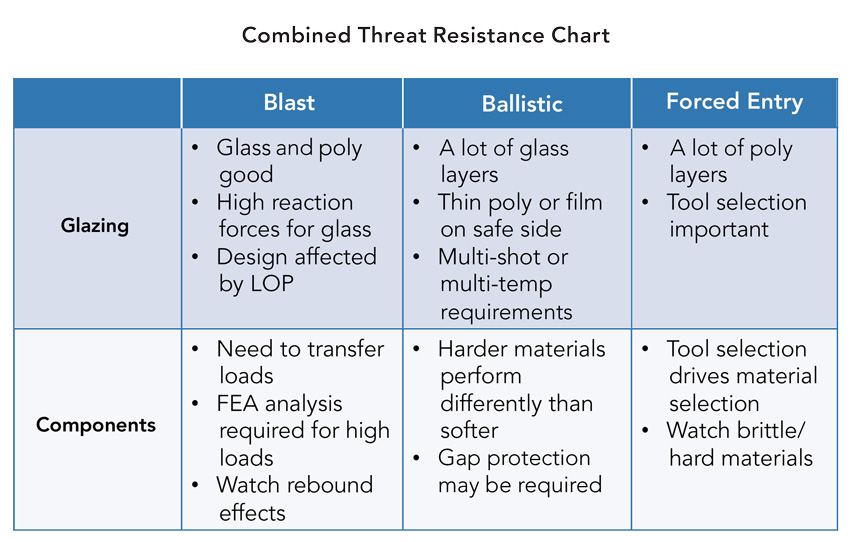
Image courtesy of Ross Technology
These are general guidelines for assessing the situation and product requirements. However, in every case, it is of critical importance to analyze threat levels in terms of each structure’s unique mission, location, assets, resources, and design priorities. The threats are evolving and multifaceted, and the response must be as well.
Summary: Key Lessons
Fenestration elements are a critical part of threat resistance in buildings and are most effective when designed as parts of an integrated system. Many product design parameters can be precisely determined according to federal, commercial and proprietary standards, testing, and experience. At the same time, there is still the opportunity—and the requirement—to customize designs for specific applications in ways that will provide protection and enhance the overall function and architecture of the building. Experienced manufacturers can be important members of the team and help to:
- Perform detailed risk assessments
- Understand the nature of physical threats to buildings from explosive blast, ballistics, and forced entry
- Develop performance requirements necessary for products to meet defined levels of threat severity and protection
- Select products and design systems suitable for the specific project
- Integrate products into the building envelope
End Note
1Patterns of Terrorism in the United States, 1970–2014. National Consortium for the Study of Terrorism and Responses to Terrorism. A Department of Homeland Security Center of Excellence led by the University of Maryland. May 2016. Web. 21 November 2016. www.start.umd.edu/pubs/CSTAB%20Year%203%20Project%202.4%20GTD-US%20Final_0.pdf.

|
Ross Technology manufactures a diverse line of physical security and public safety solutions that protect people, property, and products in a wide range of applications, including OSHA compliance, antiterrorism/force protection, and industrial storage. Based in Leola, Pennsylvania, the company supports construction and capital improvement projects throughout the world. www.rosstechnology.com |
